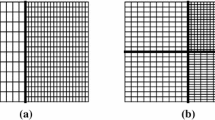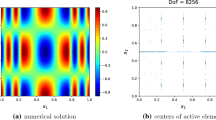Abstract
In this paper we introduce a new RKDG method for problems of wave propagation that achieves full high-order convergence in time and space. The novelty of the method resides in the way in which it marches in time. It uses an mth-order m-stage, low storage SSP-RK scheme which is an extension to a class of non-autonomous linear systems of a recently designed method for autonomous linear systems. This extension allows for a high-order accurate treatment of the inhomogeneous, time-dependent terms that enter the semi-discrete problem on account of the physical boundary conditions. Thus, if polynomials of degree k are used in the space discretization, the RKDG method is of overall order m = k + 1, for any k > 0. Moreover, we also show that the attainment of high-order space–time accuracy allows for an efficient implementation of post-processing techniques that can double the convergence order. We explore this issue in a one-dimensional setting and show that the superconvergence of fluxes previously observed in full space–time DG formulations is also attained in our new RKDG scheme. This allows for the construction of higher-order solutions via local interpolating polynomials. Indeed, if polynomials of degree k are used in the space discretization together with a time-marching method of order 2k + 1, a post-processed approximation of order 2k + 1 is obtained. Numerical results in one and two space dimensions are presented that confirm the predicted convergence properties.
Similar content being viewed by others
References
S. Abarbanel D. Gottlieb (1998) ArticleTitleOn the construction and analysis of absorbing layers in CEM Appl. Numer. Math. 27 331–340 Occurrence Handle10.1016/S0168-9274(98)00018-X
S. Adjerid T.C. Massey (2002) ArticleTitleA posteriori discontinuous finite element error estimation for two-dimensional hyperbolic problems Comput. Meth. Appl. Mech. Eng. 191 5877–5897 Occurrence Handle10.1016/S0045-7825(02)00502-9
J. Berenger (1996) ArticleTitleThree-dimensional perfectly patched layer for the absorption of electromagnetic waves J. Comput. Phys. 127 363–379 Occurrence Handle10.1006/jcph.1996.0181
E. Bleszynski M. Bleszynski T. Jaroszewicz (1996) ArticleTitleAIM: Adaptive Integral Method for solving large-scale electromagnetic and radiation problems Radio Sci. 31 1225–1251 Occurrence Handle10.1029/96RS02504
O. Bruno L. Kunyansky (2001) ArticleTitleA fast, high-order algorithm for the solution of surface scattering problems: Basic implementation, tests and application J. Comput. Phys. 169 80–110 Occurrence Handle10.1006/jcph.2001.6714
L. Canino J. Ottusch M. Stalzer J. Visher S. Wandzura (1998) ArticleTitleNumerical solution of the helmholtz equation using a high-order Nystrom discretization J. Comput. Phys. 146 627–663 Occurrence Handle10.1006/jcph.1998.6077 Occurrence HandleMR1654932
Castillo, P., Koning, J., Rieben, R., and White, D. (2004). A discrete differential forms framework for computational electromagnetism. Comput. Meth. Eng. Sci. to appear.
B. Cockburn C.-W. Shu (1998) ArticleTitleThe Runge–Kutta discontinuous Galerkin finite element method for conservation laws V: Multidimensional systems. J. Comput. Phys. 141 199–224
B. Cockburn C.-W. Shu (2001) ArticleTitleRunge–Kutta discontinuous Galerkin methods for convection-dominated problems. J. Sci. Comput. 16 173–261 Occurrence Handle10.1023/A:1012873910884
D. Colton R. Kress (Eds) (1998) Inverse Acoustic and Electromagnetic Scattering Theory Springer-Verlag Berlin/Heidelberg.
S. Gedney C. Lu (2002) ArticleTitleHigh-order integral equation solution for scattering by penetrable inhomogeneous volumes IEEE Ant. Propag. Soc. AP-S Int. Symp. (Digest) 4 614–617
S. Gottlieb C.-W. Shu (1998) ArticleTitleTotal variation diminishing Runge–Kutta schemes. Math. Comp. 67 73–85 Occurrence Handle10.1090/S0025-5718-98-00913-2
S. Gottlieb L.-A. J. Gottlieb (2003) ArticleTitleStrong stability preserving properties of Runge–Kutta time discretization methods for linear constant coefficient operators. J. Sci. Comput. 18 83–109 Occurrence Handle10.1023/A:1020338228736
S. Gottlieb C.-W. Shu E. Tadmor (2000) ArticleTitleStrong stability preserving high order time discretization methods SIAM Rev. 43 89–112 Occurrence Handle10.1137/S003614450036757X
M. Grote J. Keller (1996) ArticleTitleNonreflecting boundary conditions for time-dependent scattering, J Comput. Phys. 127 52–65 Occurrence Handle10.1006/jcph.1996.0157
M. Grote J. Keller (1998) ArticleTitleNonreflecting boundary conditions for Maxwell’s equations J. Comput. Phys. 139 327–342 Occurrence Handle10.1006/jcph.1997.5881
R. F. Harrington (Eds) (1968) Field Computation by Moment Methods Macmillan New York.
J. S. Hesthaven T. Warburton (2002) ArticleTitleNodal high-order methods on unstructured grids. I. Time-domain solution of Maxwell’s equations. J. Comput. Phys. 181 186–221 Occurrence Handle10.1006/jcph.2002.7118
K. S. Kunz R. J. Luebbers (Eds) (1993) The Finite Difference Time Domain Method for Electromagnetics CRC Press Boca Raton
E. K. Miller L. Medgyesi–Mitschang E. H. Newman (Eds) (1992) Computational electromagnetics — Frequency-Domain Method of Moments IEEE Press New York
A. H. Mohammadian V. Shankar W. F. Hall (1991) ArticleTitleComputation of electromagnetic scattering and radiation using a time-domain finite-volume discretization procedure Comput. Phys. Commun. 68 331–345 Occurrence Handle10.1016/0010-4655(91)90207-2
S. Rao (1999) Time Domain Electromagnetics Academic Press San Diego
F. Reitich K. K. Tamma (2004) ArticleTitleState-of-the-art, trends and directions in Computational Electromagnetics Comput. Meth. Eng. Sci. 5 287–294
J.M. Song Lu C.-C. Chew W. C. (1997) ArticleTitleMultilevel fast multiple algorithm for electromagnetic scattering by large complex objects IEEE Trans. Ant. Propag. 45 1488–1493 Occurrence Handle10.1109/8.633855
R. J. Spiteri S. J. Ruuth (2002) ArticleTitleA new class of optimal high-order strong-stability-preserving time discretization methods SIAM J. Numer. Anal. 40 469–491 Occurrence Handle10.1137/S0036142901389025
A. Taflove (Eds) (1995) Computational Electromagnetics: The Finite-Difference Time-domain Method Artech House Boston
Author information
Authors and Affiliations
Corresponding author
Additional information
Mathematics Subject Classification 1991: Primary 65N30; Secondary 65M60.
Rights and permissions
About this article
Cite this article
Chen, MH., Cockburn, B. & Reitich, F. High-order RKDG Methods for Computational Electromagnetics. J Sci Comput 22, 205–226 (2005). https://doi.org/10.1007/s10915-004-4152-6
Received:
Accepted:
Issue Date:
DOI: https://doi.org/10.1007/s10915-004-4152-6




